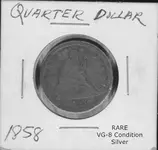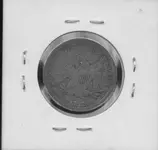Worth further checking out but I think the weight issue is a dead give away. Is your scale accurate? By over a gram, you are 15-20% off weight. I am not an expert on how wear affects coin weight, but that seems high to me. I'd take that quarter and lay it next to an unworn seated liberty quarter and compare how much thinner this coin is than an unworn one. If it seems like it is 20% thinner, perhaps you have something... But remember we are talking not just about surface detail, but actual coin thinning.
As to the color though, especially if this was a dug coin, color is no indication. If the coin was in the presence of sulfur, sulfur dioxide, sulfuric acid, etc it can become grey or darkened. I have dug silver which are black, grey, and white (like paper not shiny). The fact is, you don't know what is around which the silver may have reacted with, nor do you know how deep below the surface of the coin that reaction went.
Also, the only metal that really is magnetic is Iron, so Iron alloys, steel etc are it; cobalt and nickel also are attracted to magnets (paramagnetic), but a US nickel does not have a high enough nickel content to be attracted by a magnet. Nickel is such a hard metal, that an alloy that was sufficiently high enough in nickel content to be noticeably attracted to a magnet, would be virtually impossible for a counterfeiter, especially at that period, to press. The early US shield nickels (which were only 25% nickel content) oftentimes missed details b/c the mint could not make a hard enough strike on the metal.
So, if your coin is counterfeit, my guess is its magnetic due to an iron core that was plated or coated with a secondary gray metal or it is some type of steel. However, such a counterfeit would probably experience some sort of corrosion overtime due to the bi-metallic content. If it has an iron core, likely since its not corroded, I'd guess the exterior is silver. It may be that it was cored (a small hole in the rim where silver was excavated, and replaced with iron (but I doubt this) -- usually this was done with gold coins, and they were re-filled with lead).
More likely, like another poster said, send your metal detector over it. If it had an iron core, it should read much lower than a quarter should. If it is steel (which if it were in the ground it would be rusted away), your detector will register like iron junk over it. Most magnetic fakes of coins are some form of steel.
I don't know enough about how wear of a coin affects weight, but if you are off that much I do think something is suspect.
At any rate it is still a nice find







